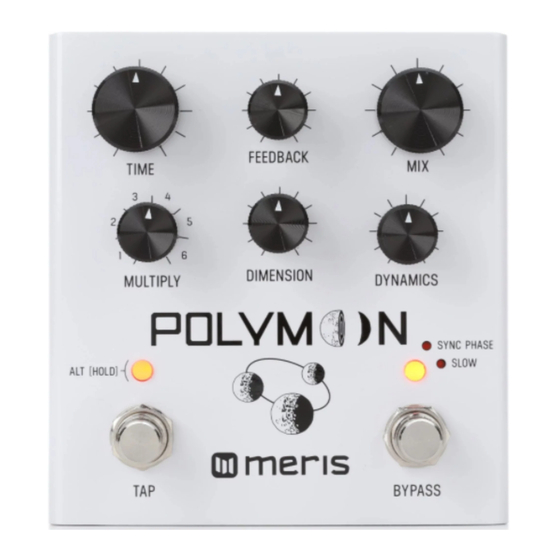
Subscribe to Our Youtube Channel
Summary of Contents for Meris Polymoon
- Page 1 M O R E T H A N L O G I C . U N I T I N G A R T + E N G I N E E R I N G . C O N T A C T email: info@meris.us phone: 747.233.1440...
- Page 2 TAB LE OF CONTENTS SECTION 1 PG. 1 FRONT PANEL CONTROLS SECTION 2 PG. 2-4 GLOBAL SETTINGS CONFIGURATION MODE SECTION 3 PG. 4 DESIGN CONCEPT SECTION 4 PG. 4-6 SIGNAL FLOW OVERVIEW 4a - DYNAMIC FLANGER 4b - DELAY LINE NETWORK 4c - DELAY NETWORK HEX MODULATION 4d - DUAL BARBERPOLE PHASER SECTION 5...
- Page 3 SECTION 1 - FRONT PANEL CONTROLS Feedback: Sets the feedback amount Alt Function: Feedback Filter Controls filter in the Mix: Adjusts the balance between feedback path. Set to noon for no Dry and Wet signals filtering, set towards minimum for a darker filter, set Time: Sets the time for the delay and the Alt Function: Delay Level Sets the towards maximum for a brighter filter...
- Page 4 SECTION 2 - GLOBAL SETTINGS CONFIGURATION MODE TO START GLOBAL SETTING INPUT MODE: LINE/SY CONFIGURATION MODE (L) LED indicates MONO (R) LED indicates TRS HOLD (L) LED switch on power up (power up takes 3 secs); all of the front panels LEDs will blink 3 times KILL DRY: EXPRESSION MIDI TH...
-
Page 5: Bypass Mode
LINE/SYNTH LEVEL: BYPASS MODE: (L) LED indicates (R) LED indicates LINE LEVEL (L) LED indicates (R) LED indicates INSTRUMENT LEVEL BUFFERED BYPASS RELAY BYPASS MIDI THRU ON: GLOBAL TEMPO: Toggle (R) foot switch Toggle (L) foot switch Trails Glide Trails Glide (L) LED indicates MIDI OUT (R) LED indicates MIDI THRU... -
Page 6: Midi Channel
SECTION 3 - DESIGN CONCEPT The seed of inspiration for the Polymoon lies in the ways that Holdsworth and Zappa would use and cascade the rack delays of the 80’s. The Polymoon opens up those concepts by vastly increasing the ability to modulate and morph every single parameter. - Page 7 SECTION 4B - DELAY LINE NETWORK IN DEPTH The Polymoon’s Delay Line network is structured as 6 delays each with their own output and modulation source. The Feedback Knob provides a global delay feedback for the whole delay network, with our custom Feedback Filter providing color to the repeats.
- Page 8 FILTER IS FLAT At the output of the delay line network, the Polymoon has two barberpole phasers one for each side of the stereo spec- trum. Each phaser is set to travel and regenerate in an opposing direction to create an wide stereo field. The top layer Phaser button allows you to select between a fixed speed of 0.1 Hz (Slow LED On), speed linked to a quarter note of the delay time (Sync...
- Page 9 “toe up” to the “toe down” settings of the expression pedal, just unplug the cable from the Polymoon at the EXP jack and then plug it back in. It’s a really useful shortcut so you don’t have to manually recreate your sound if all you want the expression pedal to change is just one parameter.
- Page 10 Tap Switch For the Polymoon, the external switch controls Tap Tempo and has all of the same functionality as the tap button on the main pedal, this includes half speed. As with the main tap switch, if you hold the externally connected tap switch, it will cause the delays to operate at half speed.
- Page 11 Depending on the EXP Jack modes you have chosen, the Polymoon will scan the top layer knobs and update the knobs on power up. If your Polymoon is set to either “Expression Pedal” or “Tap Switch” for its EXP mode, then it will scan the knobs at power up.
- Page 12 SECTION 9 - MIDI CC TABLE control change polymoon control receive value range transmit value range CC# 04 expression pedal CC# 09 63 = 1/4 63 = 1/4 dotted note note 127 = 127 = dotted dotted CC# 14 63 =...
- Page 13 SECTION 10 - POLYMOON PRESET 1 FACTORY SETTINGS eXpression parameter KnoB position real WorlD value miDi Decimal miDi heX ’ toe up just before CloCk milliseConds of delay time time ’ toe up just after CloCk feedbaCk feedbaCk at ’...
- Page 14 SECTION 11 - TECHNICAL SPECIFICATIONS Conversion 24 bit A/D and D/A 32 bit floating point Sample Rate 48000 Hz Input Impedance 1 Meg Ohm 115dB Frequency Response 20Hz-20kHz Max Input Level +9 dBu (instrument level setting) +12.5 dBu (line/synth level setting) Power 9V DC center-negative, 150mA, 2.1mm jack Bypass...





Need help?
Do you have a question about the Polymoon and is the answer not in the manual?
Questions and answers